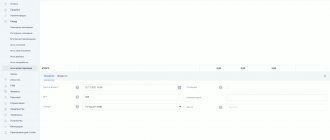Any commercial activity is associated with financial risks and unjustified losses. However, there are monetary losses that can be easily foreseen and everything possible can be done to eliminate them. You can start by updating data on warehouse balances.
In whatever form the goods are stored, be it large warehouses with high racks and clearly planned areas, small closets with boxes or covered collections of materials on the street, sooner or later the question of surplus, loss or other discrepancy of the goods with the values stored in the accounting records arises. system.
What negative impact on business does the lack of up-to-date information on the balance of goods in the warehouse entail (see Fig. 1):
- When placing an order for the supply of new batches of goods, we are based on “phantom” data: there is no accurate information about what product, in what quantity and which store is missing, and it is difficult to make sales forecasts and plan revenue and the further development of the company.
- If there is a surplus of goods, information about which is not in the accounting system, the accountant will have “red balances”. These are accounting errors, incorrect data when closing a period, additional fines and penalties.
- The company cannot guarantee prompt delivery of orders to customers when it does not have information about warehouse balances. If the data about goods in the accounting system does not coincide with the facts, then the manager can sell the client a product that is not physically available. Or vice versa - a company employee may not satisfy the client’s request, without even realizing that this product is in stock. This leads to delays, failed orders and, as a result, customer dissatisfaction and a drop in sales.
- If a company employee knows that the accounting system does not reflect the actual balances in the warehouse, then any loss can always be attributed to the system. Consequently, the lack of correct accounting can secretly encourage theft in the company.
Figure 1 - Business losses in the absence of data on warehouse balances
How can a company avoid unreasonable costs associated with storing goods in a warehouse?
There are different ways to solve this problem: putting things in order in a warehouse, ensuring proper storage conditions for goods, setting up correct accounting of expiration dates, developing special motivation for storekeepers, or conducting regular inventory and reconciliation of balances.
When is inventory required?
Order of the Ministry of Finance No. 49 dated June 13, 1995 states what an inventory is - checking the condition of an organization’s property and comparing actual indicators with accounting information.
This is a mandatory annual procedure: it is carried out before the preparation of annual financial statements. But these are not all cases when such reconciliation is required. Federal and industry standards stipulate who must carry out an inventory in an organization without fail - an inventory commission (permanent or working) when certain situations occur (Part 3 of Article 11 402-FZ dated 12/06/2011, clause 1.5 of the Guidelines from the order Ministry of Finance No. 49). These include:
- annual reporting;
- change of MOL (financially responsible person) who is responsible for inventory items;
- detection of theft, damage, abuse of goods and materials;
- reorganization and liquidation of the enterprise;
- natural disasters, fires or other emergencies.
The regulatory procedure for conducting and recording the results of inventory of inventory items is prescribed in the Guidelines approved by Order of the Ministry of Finance No. 49. Inventory items include goods, tangible assets and finished products. During the annual reconciliation, all inventory items are checked. But when the MOL is changed or theft is carried out, a random check is carried out - for a specific area.
IMPORTANT!
The commission inventories its own inventory and materials on the balance sheet and materials on off-balance sheet accounts, the ownership rights to which belong to other organizations (goods in storage, materials in processing, leased property).
Making a choice in favor of effective inventory
Whatever method you choose (carry out manual reconciliation or automate the process), whatever TSD or accounting system you use, the main thing is to achieve your inventory goals, namely, eliminate inaccuracies in the accounting of goods in the warehouse, update this information and obtain reliable data , which in turn will help reduce unnecessary costs.
However, it is important not to forget about the risks of manual inventory, and also consider the cost of automating the process. Therefore, we recommend taking into account the following criteria when organizing the process:
- company turnover;
- number and size of warehouses;
- number of employees - storekeepers;
- business tasks.
A regular and well-functioning inventory process will help reduce the company’s unreasonable costs, the time required to carry out the procedure, and will also ensure the reliability of the results obtained and up-to-date information for making management decisions.
The procedure and frequency of inventory
According to the rules, a planned inventory of inventory items is carried out once a year - before drawing up the final financial statements. Typically, an inspection is organized from October 1 to December 31: to confirm that the accounting data corresponds to the actual balances of materials.
IMPORTANT!
If reconciliation of inventory items was carried out after October 1, then there is no need to organize another procedure before the formation of annual accounting reports (clause 27 of Order of the Ministry of Finance No. 34n dated July 29, 1998).
The head of the institution has the right to independently order an inspection, but for this he needs to establish the number of reconciliations for the reporting year, determine their dates and specify the inventory items or obligations being checked (clause 2.1 of section 2 of the Methodology from Order No. 49). The local procedure for carrying out reconciliation should be fixed in the accounting policy of the organization (clause 3 of article 6 402-FZ).
Let's look at how an inventory is carried out for dummies - the procedure consists of several stages: preparation, the inspection itself, comparison of actual and accounting data, registration of the results and reflection of the results in accounting. Each stage should be documented using one of the existing unified forms or a register independently developed by the organization.
Step-by-step instructions on how to conduct an inventory at an enterprise, taking into account legal norms and rules:
Step 1. Preparation
Before starting the procedure, it is necessary to issue an order to conduct an inspection, form a commission and determine the timing of the event. Usually the order is drawn up on the standardized INV-22 form, but this is not necessary. Your own form of order is allowed.
There is one more important rule: financially responsible persons, before conducting an inventory of goods and materials, are required to provide the commission with receipts and expenditure documents (reports on the movement of inventory items), which they did not transfer to the accounting department, and receipts stating that all receipts and expenditure registers for the goods and materials being checked have been handed over to the accountant or members of the commission, the valuables are capitalized, and the disposed materials are written off (clause 2.4 of the Method of Instructions). In addition, each MOL provides inventory lists and acts on its own forms or standardized ones - INV-1, 3, 4 and others.
Step 2. Verification
The procedure is carried out only in the presence of all members of the commission and the MOL (clause 2.8 of the Methods). An exception is if the MOL is absent from work for a long time due to illness or avoids taking inventory. But in this case, it is important to notify the financially responsible person about the upcoming inspection with documents. But if at least one member of the commission is absent during the inventory, then its results automatically become invalid.
The check is carried out using printouts of the inventory list INV-3. Inventory items are counted, weighed, measured and their actual presence is checked (clause 2.7 of the Methods).
Step 3: Data Mapping
The commission reflects the actual state of inventory items in inventory records and acts. MOLs sign the registers, confirming that the inspection was carried out in their presence. If, when comparing actual and accounting information, discrepancies are identified, then a matching statement is drawn up using forms INV-18, 19 or a self-developed form.
Step 4. Presentation of results
After the reconciliation, a meeting of the inventory commission is held. As a result, when conducting an inventory of inventory items, not only a statement is drawn up, but also a protocol of the commission meeting. The protocol is drawn up in any form. In him:
- the results of the check are reflected;
- explanations for deviations are provided;
- the perpetrators and the procedure for bringing them to justice are indicated;
- proposals for offsetting surpluses and shortages are listed;
- general conclusions, decisions and proposals based on the results of the inventory are given.
All results are summarized in the inventory record sheet (INV-26 as an option to fill out). And the final decision is made by the manager in the order approving the inventory results.
Step 5. Reflection in accounting
The results of the annual reconciliation form the accounting indicators for the year. Based on the results of inventory procedures, all necessary entries should be made - write off shortages and inventory items that are unsuitable for use, take into account surpluses, and offset misgrading.
IMPORTANT!
All results of the inventory check must be reflected in the reporting period to which the date of its conduct refers (part 4 of article 11 402-FZ, clause 5.5 of the Methodology). It is prohibited to make changes to the approved and submitted financial statements.
Use free instructions from ConsultantPlus experts to properly conduct an inventory.
to read.
How beneficial would it be to procure inventory services from a third party?
Carrying out an inventory is a very important step to ensure the stability and profitability of a business. Often, the reasons for the ineffective work of a company specializing in sales are not the lack of sales themselves or zero activity of the target audience, but rather the human factor. Illiterate accounting, damage and undocumented waste of property are often the reasons why a business suffers losses. Involving independent, unbiased specialists from a third-party organization to conduct this type of inspection will certainly bring positive results.
What to do with surplus or shortage
In addition to orders, the basic documents for conducting an inventory of material assets are inventory lists, acts, matching and generalized statements. They determine the presence of surpluses and shortages.
If surpluses are identified during the reconciliation, they must be taken into account in accounting at market value, but without VAT and excise taxes. Surplus inventory items arrive on the date of the audit: they are reflected as part of other income. In tax accounting, excess income from inventory items based on inventory results is recognized as non-operating income (Clause 20, Article 250 of the Tax Code of the Russian Federation). Surpluses are recorded at market value and for tax accounting purposes (clauses 5, 6 of Article 274 of the Tax Code of the Russian Federation).
Shortages, on the contrary, are subject to write-off as part of other expenses. In some cases, the shortage is written off as an accounting error. All significant shortfalls are compensated by MOL.
Sometimes during an inspection, misgrading is discovered, that is, simultaneous surpluses and shortages of one product of a different grade. In the case of misgrading, it is necessary to determine the prices of such goods and set off the financial result in accounting. Offset of shortages with surpluses due to regrading in tax accounting is not allowed.
How to understand the expression inventory outsourcing?
In economic theory, there is such a term as outsourced services. To put it simply, this is a purchase by the owner of a company of a certain type of service that must be performed within a certain time period. This method is becoming increasingly popular among owners of medium and large businesses. The fact is that for each officially registered labor unit, a certain amount of financial contributions must be paid to the state treasury. This is a stable tax that is mandatory for every employer. If services are attracted from outside, and are of a so-called seasonal nature, then it will be much cheaper for the owner of any company to use the knowledge and work of temporarily hired specialists, for whom another company pays taxes. She is also responsible for their qualifications.
Inventory outsourcing is a service for recounting goods and determining the degree of their compliance with the regulatory framework, leased and performed by specialists who deal with specific types of tasks professionally.
Is there liability for failure to take inventory?
Before drawing up annual financial statements, an inventory of the organization’s property and materials is carried out annually; other mandatory cases are listed in clause 1.5 of the Methods. But liability for failure to reconcile is not established by law.
The Federal Tax Service has the right to bring an organization to tax and administrative liability for unreliable accounting and reporting data (Article 120 of the Tax Code of the Russian Federation, Article 15.11 of the Code of Administrative Offenses of the Russian Federation). But only on condition that the inspector independently discovers a discrepancy between actual indicators and accounting information.






